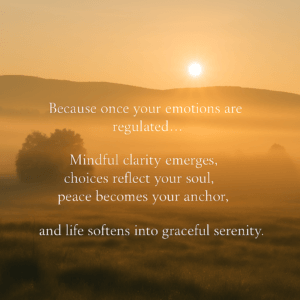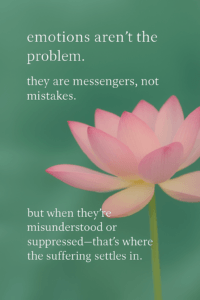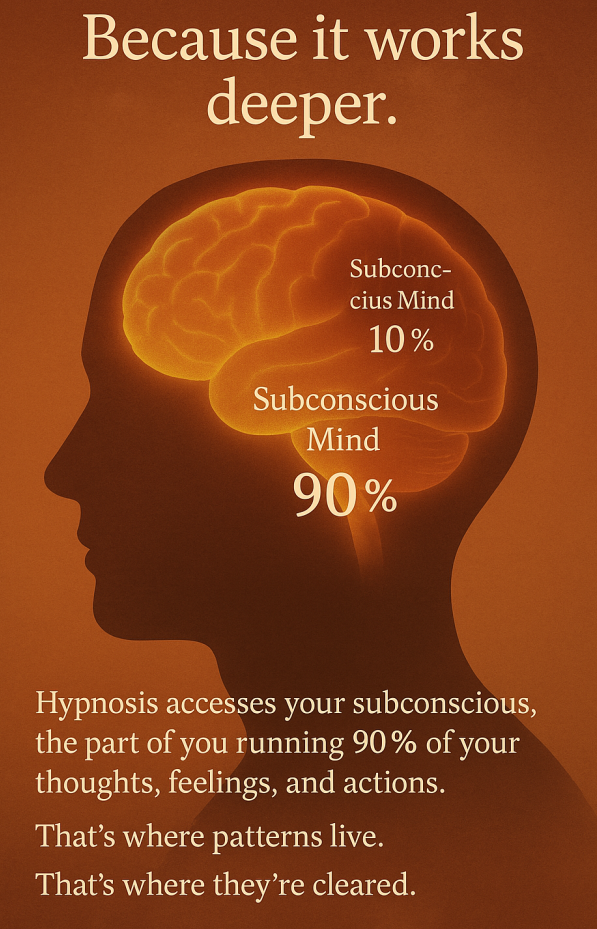You might have heard of self-hypnosis, but what exactly is it? To be clear, this isn’t about pendulums or parlor tricks. It’s not sleepwalking. It’s soul-waking.
Self-hypnosis is the ancient-meets-modern art of guiding yourself into a highly focused trance state—a quieted mind, a softened body, and an open door to the subconscious. Think of it as concentrated attention on a specific intention or meditation with direction.
Unlike the dramatized versions you’ve seen in pop culture (cue the swirling spirals and dramatic finger snaps), real self-hypnosis is a grounded, self-led practice backed by centuries of tradition and decades of science. It’s where neuroscience meets mysticism—and together, they lead you home.
In this state, you’re not unconscious. You’re more aware. More connected. More in control than ever. You can release stress. Sharpen your focus. Rewire beliefs. And yes—finally sleep like your nervous system’s been craving for years.
As the world races toward productivity and performance, self-hypnosis dares you to slow down. To listen inward. To reprogram from the inside out.
This isn’t just self-help.
This is self-remembrance.
This is soul alchemy.
 Rest Is a Revolution:
Rest Is a Revolution:
This Isn’t Therapy. This Is Soul Alchemy.
 To dive beneath the surface and reshape the subconscious from its source, hypnotherapy opens the door to a new chapter of growth, healing, and empowerment. It’s not just about change—it’s about remembering who you were before the world told you otherwise.
To dive beneath the surface and reshape the subconscious from its source, hypnotherapy opens the door to a new chapter of growth, healing, and empowerment. It’s not just about change—it’s about remembering who you were before the world told you otherwise.
Imagine sinking into a deep, safe stillness…
Where the worries of the day dissolve like fog in the morning sun.
Where the mind rests, the body softens, and your inner wisdom speaks clearly.
That’s the space hypnotherapy holds.
A space where stress unravels, and self-awareness rewires.
By gently accessing the subconscious mind, hypnotherapy helps you release tension, reframe fear, and cultivate a grounded peace that touches every corner of your life.
Struggling to break free from behaviors that no longer serve you?
Patterns like emotional eating, smoking, procrastination, or people-pleasing don’t just live on the surface—they’re rooted deep in the subconscious.
Hypnotherapy goes there.
It softens resistance and invites new neural pathways to take shape—ones aligned with your truth.
 And emotional healing?
And emotional healing?
This is where hypnotherapy shines with quiet grace.
Old wounds, past betrayals, childhood echoes—they don’t disappear by being ignored.
They dissolve when they’re seen with compassion, reframed with wisdom, and released with love.
In the hypnotic state, you don’t just cope—you reclaim.
You shift the inner scripts.
You meet the scared parts of yourself with safety.
You say: It’s safe to be me now. Fully.
 From athletes to artists, entrepreneurs to students, hypnotherapy unlocks potential that’s often dormant—waiting for permission to rise.
From athletes to artists, entrepreneurs to students, hypnotherapy unlocks potential that’s often dormant—waiting for permission to rise.
With tools like visualization, positive suggestion, and mental rehearsal, you begin to walk into rooms differently. Speak with clarity. Create with confidence. Rest with trust.
Because at its core, hypnotherapy is not about control.
It’s about choice.
It’s about accessing your own inner pharmacy, your own divine intelligence, your own capacity to heal and become.
With each session, you peel back layers. Gain insight.
And move closer to the version of you who’s been patiently waiting beneath the noise.
In the sections that follow, we’ll uncover what really happens in the brain during self-hypnosis, how it shifts your internal landscape, and why this tool is becoming a non-negotiable for those reclaiming their peace, power, and purpose.
Prefer to listen instead? …Here’s a quick summary before we dive deeper…


Forget the swinging watches and whispered commands.
That’s fiction.
The truth?
Self-hypnosis is a science-backed practice—and a sacred one too.
It’s not about losing control. It’s about reclaiming it.
Unlike the dramatized versions you’ve seen on TV, self-hypnosis is a scientifically-backed practice that has been around for centuries. Its roots go back to ancient civilizations, but it gained significant scientific interest in the 18th century. Today, self-hypnosis is gaining momentum as a practical self-help tool that can be seamlessly integrated into your daily routine.
When you enter a self-hypnotic state, you’re not spacing out… you’re tuning in.
Your mind isn’t asleep—it’s laser-focused, calm, and receptive.
You’re slipping beneath the surface noise into the deeper currents—where real change happens.
Self-hypnosis is a technique where you guide yourself into a high brainwave trance state to achieve a specific goal, like reducing stress or improving focus. It’s a self-guided process that allows you to control your own thoughts and feelings, tapping into the power of your subconscious mind.
The rise in its popularity can be attributed to its simplicity and the growing body of research supporting its effectiveness. As more people look for natural and self-directed approaches to health and well-being, self-hypnosis stands out as a valuable tool. It’s a method that can empower you to tap into your inner strengths and make the changes you desire.
 Brain imaging studies reveal something fascinating: during self-hypnosis, the regions of the brain responsible for self-awareness, emotion regulation, and focus light up like a constellation. It’s a state where the conscious mind steps aside, and the subconscious steps forward—not to overpower, but to partner with you.
Brain imaging studies reveal something fascinating: during self-hypnosis, the regions of the brain responsible for self-awareness, emotion regulation, and focus light up like a constellation. It’s a state where the conscious mind steps aside, and the subconscious steps forward—not to overpower, but to partner with you.
This isn’t mind control.
It’s mind collaboration.
You guide yourself with intention—using breath, imagery, affirmations, or visualization—to enter a deeply relaxed yet highly attuned state. In this space, old patterns can be rewritten. Emotional blocks can be cleared. And new beliefs can take root—gently, effortlessly, in the soil of your inner stillness.
Let go of the myths.
You’re never unconscious.
You’re never “under” anything.
You’re simply more present than you’ve been in a long time.
And with that presence comes power.
The kind that doesn’t shout—but whispers, “You’re safe now. You’re ready.”
In the following sections, we’ll uncover how self-hypnosis or emotional healing works and explore its profound benefits on both the mind and the body. Stay tuned as we delve into the principles behind this transformative practice.
 Clearing the Fog: How Emotional Healing Sharpens the Mind
Clearing the Fog: How Emotional Healing Sharpens the Mind
Ever feel like your thoughts are tangled headphones?
No matter how hard you try to “focus,” your mind just… loops?
That was me—until I learned the art of redirecting my attention inward.
In a world bustling with distractions, the ability to sharpen concentration is no small feat. It’s here that the daily practice of self-hypnosis shows its true potential – by allowing the mind to block out noise and hone in on the tasks at hand.
Self-hypnosis isn’t about zoning out. It’s about zoning in.
It helps you clear the internal static so your thoughts move like a stream—not a storm.
In this state, distraction softens. Clarity returns.
Your to-do list no longer feels like a battleground—it becomes a rhythm you move through with ease.
I’ve seen it in my own life:
Tasks take less energy.
Ideas come more freely. Challenges are faced with more resilience.
I’m not just productive—I’m present.
And the science backs it up. Studies suggest that self-hypnosis can improve concentration, extend attention span, and even enhance memory retention. It’s like giving your brain a gentle tune-up each time you practice.
But here’s the magic—it’s subtle at first.
The benefits unfold like dawn. Quiet, but undeniable.
It’s not just about getting through the to-do list; it’s the quality and efficiency of how tasks are completed. When self-hypnosis becomes a part of the daily routine, the mind learns to focus more intensely and more quickly. 
It’s not just about getting through the to-do list; it’s the quality and efficiency of how tasks are completed. When self-hypnosis becomes a part of the daily routine, the mind learns to focus more intensely and more quickly.
Now, this isn’t a magical cure-all. The improvements are subtle at first. It requires commitment and patience, but the rewards are well worth it. Over time, this practice can rewire the brain to naturally adopt a more focused state, steering away from the endless cycle of distraction and procrastination that plagues so many.
Because when you train your mind to pause… to listen… to focus inward first—
you start leading your day with clarity instead of chaos.
Let me leave you with this thought before moving on to the next point – imagine ending your day feeling accomplished, rather than frazzled and spent. The daily practice of self-hypnosis is a strong ally in this pursuit, offering a path to refined mental clarity and sharp focus.So ask yourself—what would it feel like to end the day feeling complete instead of just depleted?
That’s not productivity.
That’s alignment.
 Softening the Storm: Alchemy for Anxiety & Stress
Softening the Storm: Alchemy for Anxiety & Stress
Stress doesn’t ask for permission.
It creeps in, tightens the chest, speeds the heart, clutters the mind.
But here’s the truth I’ve come to know:
 You don’t have to fight the storm. You can learn to quiet the wind.
You don’t have to fight the storm. You can learn to quiet the wind.
With self-hypnosis, you’re not just coping—you’re rewiring. You guide yourself into a calm, inward state where your nervous system finally gets the memo: We’re safe now. It’s okay to breathe.
This practice doesn’t require hours, incense, or a mountain retreat.
Sometimes, five minutes is enough.
Five minutes to close your eyes.
To slow your breath.
To choose a new direction for your mind to follow.
With each session, your body remembers. Your mind learns how to respond instead of react. Your breath becomes a bridge—from panic to peace.
And over time?
That bridge becomes your default path.
 Science supports what many of us have felt firsthand—self-hypnosis can reduce cortisol levels, ease anxiety, and calm the chaos within. Not through avoidance, but through presence. Not by numbing—but by nurturing.
Science supports what many of us have felt firsthand—self-hypnosis can reduce cortisol levels, ease anxiety, and calm the chaos within. Not through avoidance, but through presence. Not by numbing—but by nurturing.
No side effects. No shame. No pressure to perform.
Just you. Meeting yourself in stillness. And letting that stillness do what it’s always known how to do—heal.
Continuing your self-hypnosis journey, you’ll likely notice another benefit: improved sleep patterns. As you learn to manage daytime stress, this state of relaxation can extend into your nights. This seamless transition into the next benefit highlights how self-hypnosis can contribute to overall mind-body wellness.
 Coming Home to Wholeness: The Power of Restorative Sleep
Coming Home to Wholeness: The Power of Restorative Sleep
At the heart of self-hypnosis lies something so many of us silently crave—deep, restorative sleep. Not just more hours in bed, but true rest.
The kind that mends.
That resets the nervous system.
That lets the body exhale and the soul remember: you are safe now.
When you gently guide your mind into stillness, you’re not just calming your thoughts—
you’re giving your entire being permission to regenerate. The body begins to heal. The subconscious begins to clear. And the spirit begins to rise.
 This is the alchemy of emotion. Where inner noise is quieted. Where past wounds are met with compassion. Where you’re no longer surviving the day—
This is the alchemy of emotion. Where inner noise is quieted. Where past wounds are met with compassion. Where you’re no longer surviving the day—
you’re awakening within it.
Because sleep isn’t just a health goal.
It’s a portal.
A sacred reset.
A return to your natural rhythm—one that the modern world has worked hard to drown out.
And when your sleep improves, so does everything else.
⚬ Your focus sharpens.
⚬ Your creativity flows.
⚬ Your decisions align with clarity instead of fear.
⚬ Your relationships deepen, because you’re no longer running on empty.
⚬ And most importantly—you reconnect with yourself.
Not the self shaped by expectation or performance—but the true self beneath the programming. The one who is whole. Worthy. And wildly capable of healing.

This is what emotional alchemy makes possible—returning home to truth, tranquility, prosperity, and wholeness.
So if you’ve been restless, frazzled, overextended, or quietly unraveling beneath the surface—
remember: your peace is not lost. It’s just waiting for a signal.
Let stillness be that signal.
Let rest be your rebellion.
And let your breath be the doorway back to wholeness.
Because healing doesn’t have to be loud.
And awakening doesn’t have to be forced.
Sometimes, it begins with closing your eyes…
and simply listening within.



